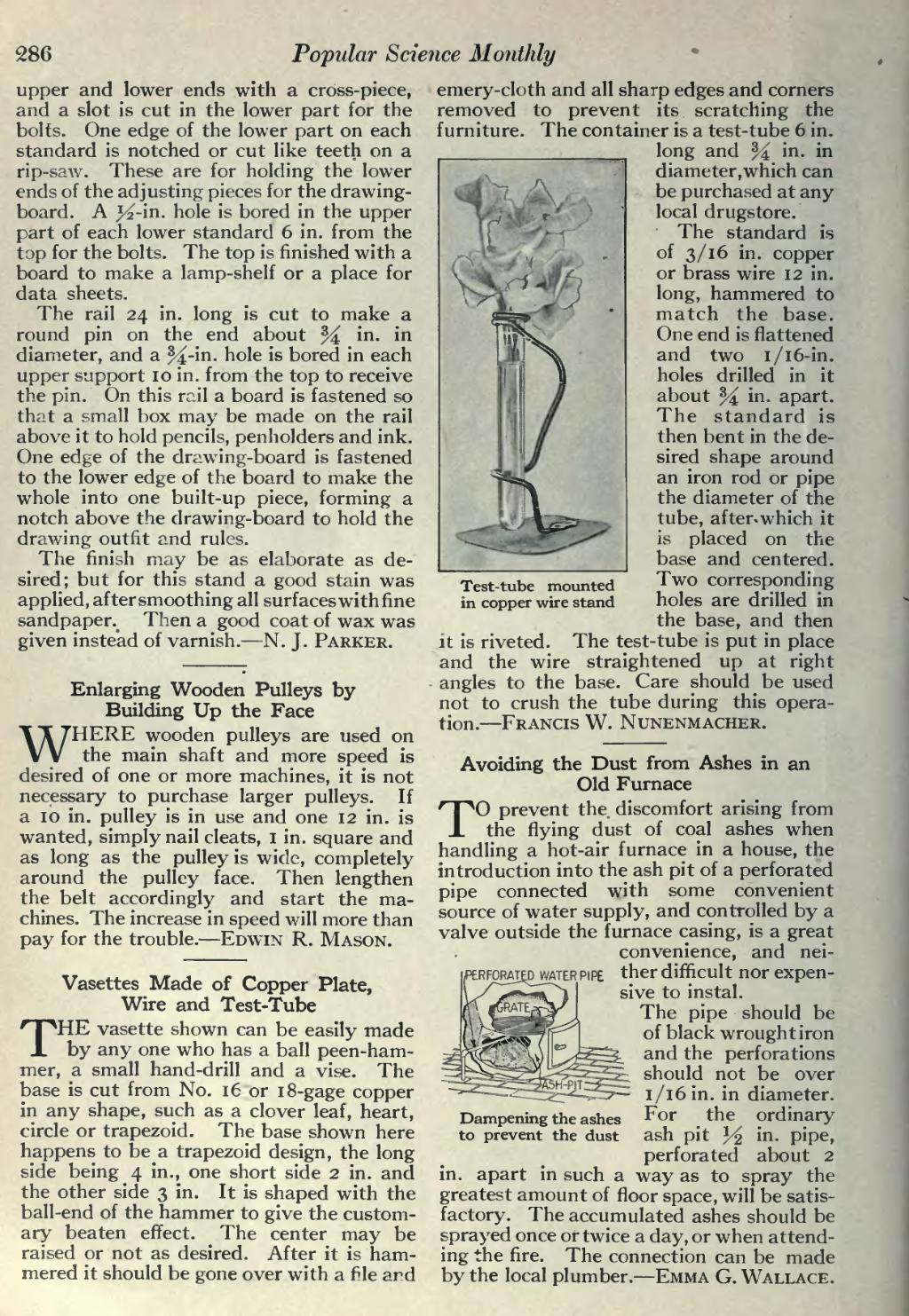286
��Popular Science Monthly
��upper and lower ends with a cross-piece, and a slot is cut in the lower part for the bolts. One edge of the lower part on each standard is notched or cut like teeth on a rip-saw. These are for holding the lower ends of the adjusting pieces for the drawing- board. A ^-in. hole is bored in the upper part of each lower standard 6 in. from the top for the bolts. The top is finished with a board to make a lamp-shelf or a place for data sheets.
The rail 24 in. long is cut to make a round pin on the end about ^ in, in diameter, and a y^-in. hole is bored in each upper support 10 in. from the top to receive the pin. On this rail a board is fastened so that a small box may be made on the rail above it to hold pencils, penholders and ink. One edge of the drawing-board is fastened to the lower edge of the board to make the whole into one built-up piece, forming a notch above the drawing-board to hold the drawing outfit and rules.
The finish may be as elaborate as de- sired; but for this stand a good stain was applied, aftersmoothing all surfaces with fine sandpaper.^ Then a good coat of wax was given instead of varnish. — N. J. Parker.
��Enlarging Wooden Pulleys by Building Up the Face
WHERE wooden pulleys are used on the main shaft and more speed is desired of one or more machines, it is not necessary to purchase larger pulleys. If a 10 in. pulley is in use and one 12 in. is wanted, simply nail cleats, i in. square and as long as the pulley is wide, completely around the pulley face. Then lengthen the belt accordingly and start the ma- chines. The increase in speed will more than pay for the trouble. — Edwin R. Mason.
��Vasettes Made of Copper Plate, Wire and Test-Tube
THE vasette shown can be easily made by any one who has a ball peen-ham- mer, a small hand-drill and a vise. The base is cut from No. 16 or i8-gage copper in any shape, such as a clover leaf, heart, circle or trapezoid. The base shown here happens to be a trapezoid design, the long side being 4 in., one short side 2 in. and the other side 3 in. It is shaped with the ball-end of the hammer to give the custom- ary beaten efTect. The center may be raised or not as desired. After it is ham- mered it should be gone over with a file and
��emery-cloth and all sharp edges and corners removed to prevent its scratching the furniture. The container is a test-tube 6 in. long and ^i in. in diameter, which can be purchased at any local drugstore.
The standard is of 3/16 in. copper or brass wire 12 in. long, hammered to match the base. One end is flattened and two i/i6-in. holes drilled in it about ^ in. apart. The standard is then bent in the de- sired shape around an iron rod or pipe the diameter of the tube, afterxwhich it is placed on the base and centered. Two corresponding holes are drilled in the base, and then it is riveted. The test-tube is put in place and the wire straightened up at right angles to the base. Care should be used not to crush the tube during this opera- tion. — Francis W. Nunenmacher.
���Test-tube mounted in copper wire stand
��Avoiding the Dust from Ashes in an Old Furnace
TO prevent the discomfort arising from the flying dust of coal ashes when handling a hot-air furnace in a house, the introduction into the ash pit of a perforated pipe connected with some convenient source of water supply, and controlled by a valve outside the furnace casing, is a great convenience, and nei- ther diilficult nor expen- sive to instal.
The pipe should be of black wrought iron and the perforations should not be over l/i6in. in diameter. For the ordinary ash pit ^2 in- pipe, perforated about 2 way as to spray the greatest amount of floor space, will be satis- factory. The accumulated ashes should be sprayed once or twice a day, or when attend- ing the fire. The connection can be made by the local plumber. — Emma G. Wallace.
���Dampening the ashes to prevent the dust
in. apart in such
�� �
